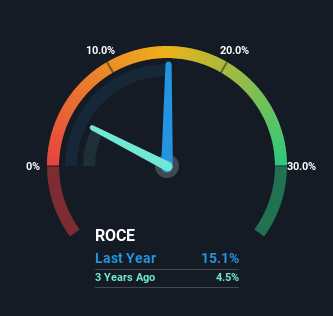- India
- /
- Auto Components
- /
- NSEI:SHIVAMAUTO
Investors Will Want Shivam Autotech's (NSE:SHIVAMAUTO) Growth In ROCE To Persist
What are the early trends we should look for to identify a stock that could multiply in value over the long term? Ideally, a business will show two trends; firstly a growing return on capital employed (ROCE) and secondly, an increasing amount of capital employed. Ultimately, this demonstrates that it's a business that is reinvesting profits at increasing rates of return. With that in mind, we've noticed some promising trends at Shivam Autotech (NSE:SHIVAMAUTO) so let's look a bit deeper.
Return On Capital Employed (ROCE): What Is It?
If you haven't worked with ROCE before, it measures the 'return' (pre-tax profit) a company generates from capital employed in its business. To calculate this metric for Shivam Autotech, this is the formula:
Return on Capital Employed = Earnings Before Interest and Tax (EBIT) ÷ (Total Assets - Current Liabilities)
0.15 = ₹436m ÷ (₹6.2b - ₹3.3b) (Based on the trailing twelve months to September 2022).
Thus, Shivam Autotech has an ROCE of 15%. In absolute terms, that's a pretty normal return, and it's somewhat close to the Auto Components industry average of 14%.
Check out our latest analysis for Shivam Autotech

While the past is not representative of the future, it can be helpful to know how a company has performed historically, which is why we have this chart above. If you'd like to look at how Shivam Autotech has performed in the past in other metrics, you can view this free graph of past earnings, revenue and cash flow.
What Can We Tell From Shivam Autotech's ROCE Trend?
You'd find it hard not to be impressed with the ROCE trend at Shivam Autotech. The figures show that over the last five years, returns on capital have grown by 145%. That's a very favorable trend because this means that the company is earning more per dollar of capital that's being employed. Speaking of capital employed, the company is actually utilizing 27% less than it was five years ago, which can be indicative of a business that's improving its efficiency. A business that's shrinking its asset base like this isn't usually typical of a soon to be multi-bagger company.
On a side note, we noticed that the improvement in ROCE appears to be partly fueled by an increase in current liabilities. The current liabilities has increased to 54% of total assets, so the business is now more funded by the likes of its suppliers or short-term creditors. And with current liabilities at those levels, that's pretty high.
The Key Takeaway
In a nutshell, we're pleased to see that Shivam Autotech has been able to generate higher returns from less capital. Although the company may be facing some issues elsewhere since the stock has plunged 71% in the last five years. Regardless, we think the underlying fundamentals warrant this stock for further investigation.
Shivam Autotech does come with some risks though, we found 2 warning signs in our investment analysis, and 1 of those is significant...
While Shivam Autotech may not currently earn the highest returns, we've compiled a list of companies that currently earn more than 25% return on equity. Check out this free list here.
New: Manage All Your Stock Portfolios in One Place
We've created the ultimate portfolio companion for stock investors, and it's free.
• Connect an unlimited number of Portfolios and see your total in one currency
• Be alerted to new Warning Signs or Risks via email or mobile
• Track the Fair Value of your stocks
Have feedback on this article? Concerned about the content? Get in touch with us directly. Alternatively, email editorial-team (at) simplywallst.com.
This article by Simply Wall St is general in nature. We provide commentary based on historical data and analyst forecasts only using an unbiased methodology and our articles are not intended to be financial advice. It does not constitute a recommendation to buy or sell any stock, and does not take account of your objectives, or your financial situation. We aim to bring you long-term focused analysis driven by fundamental data. Note that our analysis may not factor in the latest price-sensitive company announcements or qualitative material. Simply Wall St has no position in any stocks mentioned.
About NSEI:SHIVAMAUTO
Shivam Autotech
Engages in the manufacture and sale of auto transmission components for original equipment manufacturers in India and internationally.
Mediocre balance sheet and slightly overvalued.
Market Insights
Weekly Picks


Crazy Undervalued 42 Baggers Silver Play (Active & Running Mine)


Fiducian: Compliance Clouds or Value Opportunity?

Willamette Valley Vineyards (WVVI): Not-So-Great Value
Recently Updated Narratives

PSIX The timing of insider sales is a serious question mark


The Great Strategy Swap – Selling "Old Auto" to Buy "Future Light"


Not a Bubble, But the "Industrial Revolution 4.0" Engine
Popular Narratives


MicroVision will explode future revenue by 380.37% with a vision towards success


NVDA: Expanding AI Demand Will Drive Major Data Center Investments Through 2026




